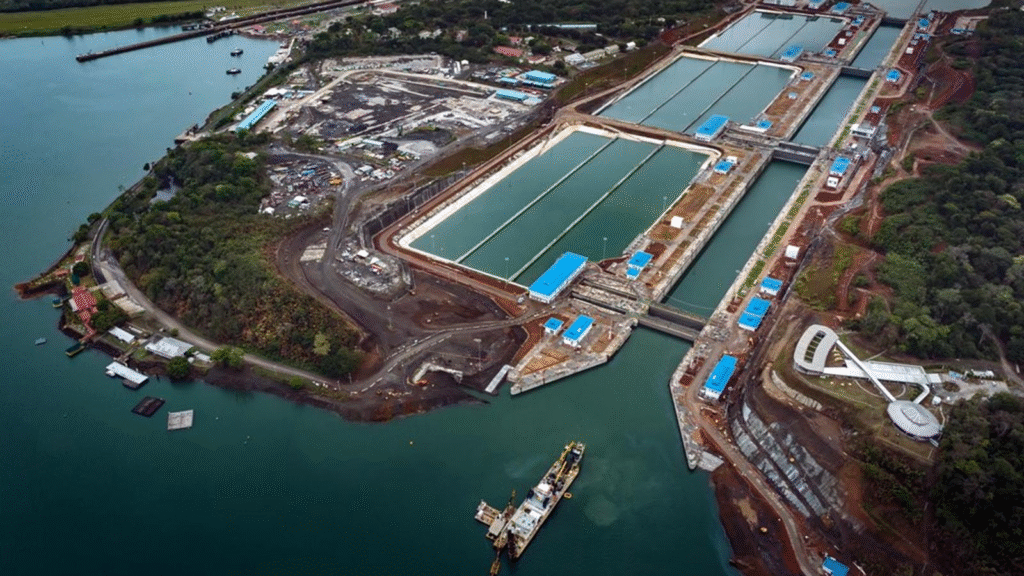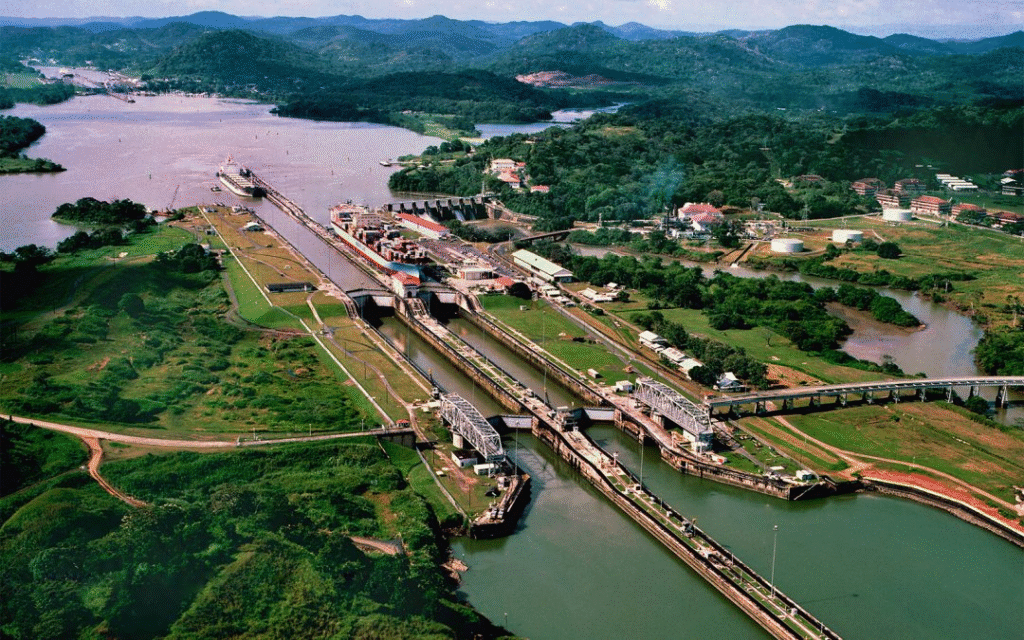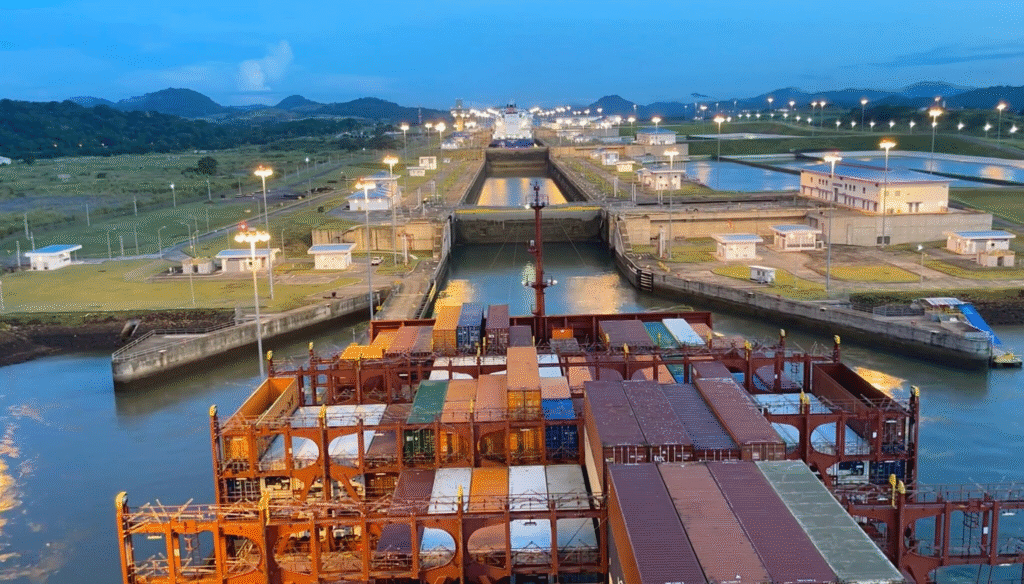The Panama Canal: A Linchpin of Global Trade
“The Panama Canal’s stands as a monumental feat of engineering, a testament to human ambition and a crucial artery for global commerce. This vital waterway, nestled in the heart of Panama, dramatically reshaped maritime trade routes and continues to play an indispensable role in the 21st century. The Panama Canal’s impact is undeniable, showcasing the Panama Canal’s significance. Understanding the Panama Canal’s operation and the Panama Canal’s history reveals its importance.”
What the Panama Canal Is
What it is: An artificial 82-kilometer (51-mile) waterway in Panama. Connects the Atlantic Ocean (via the Caribbean Sea) and the Pacific Ocean. A crucial conduit for maritime trade, eliminating the need to travel around the southern tip of South America.
“The vision of a shortcut between the Atlantic and Pacific oceans dates back centuries, but it was the United States that ultimately brought this ambitious project to fruition. After an initial, ultimately unsuccessful, attempt by France, the US took over and completed the Panama Canal’s construction in 1914, marking the success of the Panama Canal’s undertaking. This achievement highlighted the Panama Canal’s strategic importance, a testament to the Panama Canal’s engineering, solidifying the Panama Canal’s place in history.”
How the Panama Canal Works

How it works: The Panama Canal doesn’t simply cut through land; it cleverly utilizes a system of locks to navigate the varying elevations. Uses a system of locks to raise ships 26 meters (85 ft) to the level of Gatun Lake and then lower them on the other side. This ingenious design allows massive vessels to traverse the isthmus efficiently. The canal features three sets of locks: Gatún (Atlantic), Pedro Miguel, and Miraflores (Pacific). These locks operate using gravity, drawing water from Gatun Lake for the lock system.
Key Facts About the Panama Canal
Key Facts: The impact of the Panama Canal is undeniable. Completed in 1914 by the United States, it quickly became a cornerstone of international shipping. While France initially started construction in 1881 but abandoned it, the American effort persevered. Today, it takes about 8-10 hours for a ship to transit the canal, a fraction of the time it would take to circumnavigate South America. Annually, around 13,000 to 14,000 ships use it.
The tolls are based on ship size and cargo volume; the largest can be around $450,000, reflecting the immense value the canal provides. Interestingly, the smallest toll ever paid was $0.36 by a swimmer. Recognizing the evolving needs of global shipping, the canal was expanded in 2016 to accommodate larger “Neopanamax” ships, ensuring its continued relevance.
Historical Significance of the Panama Canal
Historical Significance: The idea for a canal dates back to the 16th century, highlighting its long-held strategic importance. The US gained control of the construction after Panama’s independence, a pivotal moment in the region’s history. For much of the 20th century, the US controlled the canal until December 31, 1999, when it was handed over to Panama, marking a significant shift in sovereignty.
Economic and Strategic Importance
Economic and Strategic Importance: The Panama Canal’s economic and strategic value cannot be overstated. It significantly reduces travel time and costs for shipping, making global trade more efficient. As a result, it is vital for global supply chains, connecting major trade routes between the Atlantic and Pacific. Its engineering marvel and global impact have led it to be considered one of the “Seven Wonders of the Modern World.”
Recent Challenges Facing the Panama Canal
Recent Challenges: Despite its enduring importance, the Panama Canal faces contemporary challenges. Recently, it has experienced prolonged drought, leading to reduced ship traffic and draft limitations, highlighting the impact of climate change on critical infrastructure.
The Future of the Panama Canal

Looking ahead, the Panama Canal continues to adapt to the evolving landscape of global trade. The expansion project, completed in 2016, was a significant step in accommodating larger vessels and increasing capacity. However, challenges such as climate change, particularly the increasing frequency and intensity of droughts, pose a threat to the canal’s operations.
The Panama Canal Authority is actively exploring solutions to ensure the long-term sustainability of the waterway. These efforts include water conservation measures, potential reservoir projects, and innovative operational adjustments to mitigate the impact of water scarcity.
Furthermore, the canal’s strategic location positions it as a key player in emerging global trade dynamics. As new trade routes and economic powers emerge, the Panama Canal’s ability to efficiently connect the Atlantic and Pacific remains crucial. Its ongoing modernization and adaptation will be essential in maintaining its role as a vital artery of international commerce in the decades to come.
The legacy of the Panama Canal, from its ambitious inception to its ongoing operation, is one of human ingenuity and its profound impact on the world. It stands not only as an engineering marvel but also as a symbol of global interconnectedness, a testament to the power of overcoming geographical barriers to facilitate exchange and progress.
The Broader Impact: Beyond Trade

The Panama Canal’s influence extends beyond mere economics and trade. Its construction had significant social and political ramifications, particularly for Panama itself. The presence of the United States during the construction and subsequent control of the Canal Zone shaped Panama’s national identity and its relationship with a global superpower. The eventual handover of the canal in 1999 marked a pivotal moment in Panamanian history, solidifying its sovereignty over its territory and this crucial resource.
Culturally, the Panama Canal has become an iconic symbol, representing human ambition, technological achievement, and the interconnectedness of the world. It attracts tourists from across the globe, drawn to witness the impressive lock systems and learn about the canal’s fascinating history. The communities that grew around the canal, composed of people from diverse backgrounds who came to work on the project, contributed to Panama’s rich cultural tapestry.
Furthermore, the environmental impact of the canal’s construction and operation has been a subject of ongoing consideration. The creation of Gatun Lake, while essential for the lock system, altered the local ecosystem. Today, efforts are in place to balance the canal’s operational needs with environmental sustainability, recognizing the importance of preserving the region’s biodiversity.
In essence, the Panama Canal is more than just a waterway; it is a complex entity with historical, political, social, cultural, and environmental dimensions that continue to shape the world in various ways. Its story is a compelling narrative of human endeavor, international relations, and the ongoing interplay between progress and the environment.
In conclusion, the Panama Canal remains a vital link in the global trade network, a remarkable feat of engineering with a rich history and significant economic and strategic importance. While facing new challenges, its role in facilitating international commerce ensures its continued relevance for years to come.










